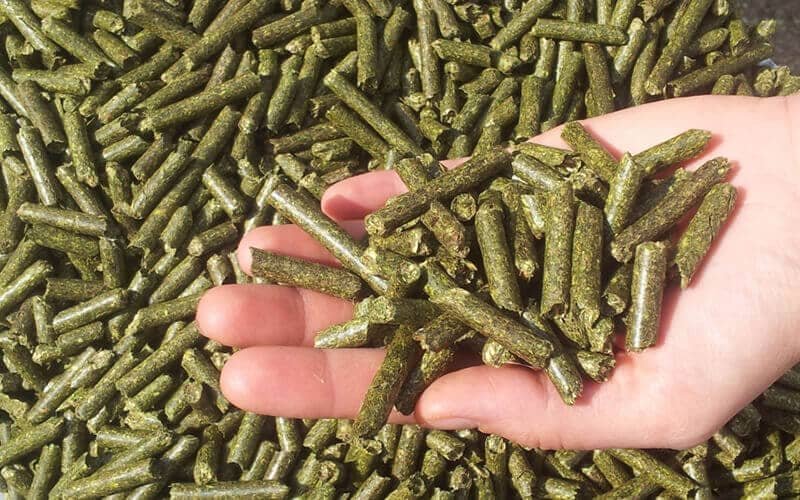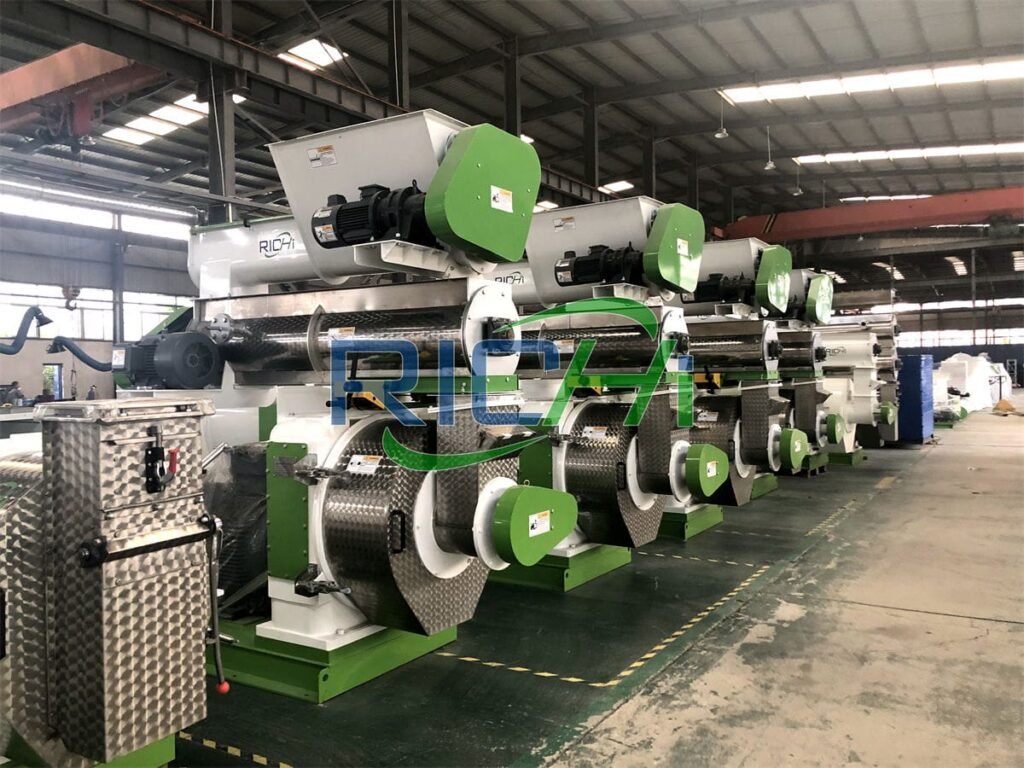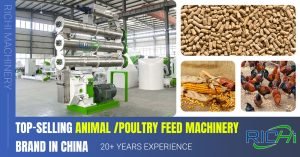Livestock feed pellet machines are essential tools in modern animal husbandry, designed to process a wide array of raw materials into compact, easily digestible pellets. These machines play a critical role in enhancing feed efficiency, minimizing waste, and improving the overall nutritional value of animal diets. This article delves into the various types of feed that can be processed using livestock feed pellet machines, showcasing their capabilities and the benefits they offer in animal nutrition.
Grain-Based Feeds
Livestock feed pellet machines are particularly effective at processing a variety of grains and their byproducts, which form the foundation of many livestock diets due to their high carbohydrate content:
- Corn
- Wheat
- Barley
- Oats
- Sorghum
- Rice Bran
- Wheat Bran
These grains are essential for providing energy to livestock, making them a staple in feed production.
Protein-Rich Ingredients
High-protein ingredients are vital for the growth and muscle development of livestock, and feed pellet machines can efficiently incorporate these into pellets:
- Soybean Meal
- Cottonseed Meal
- Sunflower Meal
- Peanut Meal
- Fish Meal
- Blood Meal
- Feather Meal
These protein sources are crucial for ensuring that livestock receive the necessary nutrients for healthy growth.

Forage and Fibrous Materials
Livestock feed pellet machines are capable of processing various fibrous materials, which are particularly important for ruminants:
- Alfalfa
- Timothy Hay
- Grass Hay
- Straw
- Corn Stalks
- Sugar Beet Pulp
These materials provide the necessary fiber for proper digestion and can be pelletized to improve storage and handling efficiency.
Mineral and Vitamin Premixes
To ensure balanced nutrition, essential minerals and vitamins can be evenly distributed throughout the feed pellets:
- Calcium Supplements
- Phosphorus Sources
- Trace Mineral Mixes
- Vitamin Premixes
Pelletizing these nutrients helps maintain their uniformity in each batch of feed, contributing to overall animal health.
Byproduct Feeds
Agricultural and industrial byproducts can be repurposed into valuable feed through pelletizing:
- Distillers Grains
- Brewers Grains
- Citrus Pulp
- Apple Pomace
- Vegetable Processing Waste
Transforming these byproducts into pellets not only reduces waste but also adds economic value.
Specialty Feeds
Livestock feed pellet machines are versatile enough to produce specialized feeds tailored to specific nutritional needs:
- Creep Feed for Young Animals
- Lactation Diets for Dairy Animals
- Finishing Feeds for Meat Production
- Horse Feed Blends
- Rabbit Pellets
- Goat and Sheep Feed Formulations
These tailored feeds support the unique dietary requirements of different animals at various life stages.
Organic and Non-GMO Feeds
With increasing demand for organic and non-GMO livestock products, feed pellet machines can process:
- Certified Organic Ingredients
- Non-GMO Feed Components
- Natural and Additive-Free Formulations
These options cater to niche markets and consumer preferences for sustainably produced animal products.
Medicated Feeds
Under strict regulation, livestock feed pellet machines can incorporate medications into the feed:
- Antibiotics (where permitted)
- Growth Promoters
- Coccidiostats
- Other Approved Medications
Pelletizing ensures that medications are evenly distributed, making it easier to administer the correct dosage to livestock.
Aquaculture Feeds
Many livestock feed pellet machines can be adapted for aquaculture, producing pellets for fish and other aquatic species:
- Fish Feed Pellets
- Shrimp Feed
- Floating and Sinking Aqua Feeds
These feeds require specific formulations and pellet characteristics, which can be achieved with the appropriate adjustments to the pellet machine.
Silage Additives
Some feed pellet machines are also capable of processing silage additives:
- Bacterial Inoculants
- Enzymes
- Preservatives
Pelletizing these additives allows them to be easily mixed with silage, improving fermentation and preservation.
Advantages of Using Livestock Feed Pellet Machines
Livestock feed pellet machines offer several advantages that enhance feed production:
- Improved Feed Efficiency: Pelletizing increases feed digestibility and reduces waste.
- Better Handling and Storage: Pellets are easier to transport, store, and dispense compared to loose feed.
- Reduced Feed Segregation: Ensures that animals receive a balanced diet with each serving.
- Customization: Allows for the production of pellets in various sizes and densities, catering to different species.
- Increased Palatability: Animals often prefer pellets over mash feeds, leading to higher feed intake.
- Cost-Effective: Pelletizing can incorporate lower-cost ingredients while maintaining nutritional value.
- Reduced Dust: Pellets produce less dust, improving air quality in animal housing. (Related post: small feed making machine)
Considerations for Processing Different Feeds
When processing different types of feed, several factors must be considered to ensure optimal pellet quality:
- Moisture Content: The moisture level of ingredients is crucial for effective pelletizing.
- Particle Size: Proper grinding of raw materials is necessary for good pellet quality and digestibility.
- Fat Content: High-fat ingredients may require special handling or additives to maintain pellet integrity.
- Fiber Level: High-fiber materials may need pre-processing or binders to form stable pellets.
- Heat Sensitivity: Certain nutrients or additives are heat-sensitive and require careful temperature control.
- Pellet Durability: Different animals may require pellets with varying hardness and durability.
Technological Advancements
Advancements in feed pellet machine technology have expanded their capabilities:
- Improved Die and Roller Designs: Enhance pellet quality and energy efficiency.
- Advanced Control Systems: Allow precise adjustment of processing parameters.
- Integrated Mixing and Conditioning: Improve ingredient incorporation and steam conditioning.
- Energy Recovery Systems: Reduce overall energy consumption during pellet production.
Conclusion
Livestock feed pellet machines are highly versatile, capable of processing a wide range of feed ingredients and formulations. From basic grain-based feeds to specialized organic and aquaculture diets, these machines provide the flexibility needed to meet diverse nutritional requirements and market demands.
Their ability to produce consistent, high-quality pellets makes livestock feed pellet machines indispensable in modern animal nutrition. As the industry continues to emphasize efficiency, sustainability, and animal welfare, these machines will play a vital role in meeting these challenges.
For livestock producers and feed manufacturers, investing in a versatile feed pellet machine opens up opportunities for innovation, quality improvement, and operational efficiency. By understanding the full spectrum of feed types that can be processed, producers can maximize their equipment’s potential and effectively respond to evolving market needs and nutritional insights in the dynamic field of animal nutrition.



